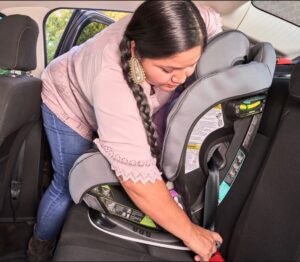A 2024 Kidz in Motion Conference session titled CPS Outreach Strategies and Resources for Tribal Nations and Spanish-Speaking Communities provided important information for any CPS program.
Addressing the topic of CPS for American Indian and Alaska Native (AI/AN) populations, presenter Jennifer Booge, CPST-I, noted that child fatality rates are eight times higher on the roadways of the nation’s 574 federally recognized tribes than elsewhere in the U.S.
Since the most effective way for CPS programs to help children in any underserved community is to encourage buy-in and build the involvement of members of that community, it is problematic that CPST certification and recertification rates are lower for AI/AN techs than for others.
One challenge, AI/AN CPSTs say, is getti instructors to come to them to do sign-offs or run certification courses (though the root causes of this anecdotal observation were not explored during the session). In a search of CPST-Instructors nationwide, Booge could identify only 13 who are members of AI/AN communities.
Booge provided some big-picture strategies for addressing these problems. She first emphasized that serving AI/AN communities requires building relationships, not simply “checking the box.” Effective education geared for an AI/AN—or any underserved—population requires adherence to the following approaches:
- Adapting materials. They should look and sound familiar to the audience.
- Being considerate of the audience’s timeline. Don’t assume outreach will fit into an arbitrary scheduling cycle.
- Being present. Offer help for the long term. A one-time presentation with no follow-up will have little lasting effect.
- Actively listening. Remember that the differences in the strengths and needs of underserved communities are often nuanced, so listening is essential.
Booge also noted the importance of not working in isolation. Any CPS program is stronger when it can lean on and collaborate with a support system. AI/AN CPS coalitions based in the Pacific Northwest (run by Olivia Whiting-Tovar), Arizona (run by Monte Yazzi), and the Midwest (run by Lisa Herritz and Jennifer Booge) have benefited from collaboration. But other areas lack such partnerships.
To fill this deficit, Booge announced that the National Safety Council (NSC) and the Albuquerque Area Southwest Tribal Epidemi-ology Center (AASTEC) are partnering to form an AI/AN CPS instructor group to mentor and provide resources to CPST-Is and instructor candidates. To join, fill out this online form.
Co-presenter Claudia Summers, CPST-I, also shared a variety of resources, including those offered through Safety Connection, a robust portal.
Audience-specific resources: Safety Connection has an American Indian/Alaska Native button and recently added a Recursos para Hispanos/Latinos button to view resource pages in Spanish. These pages are useful for both CPSTs and caregivers.
Virtual checkup services: Caregivers seeking a checkup and CPSTs needing seat check sign-offs can sign up at Safety Connection for free virtual checkups. These services are offered in Spanish as well as English.
Mentoring: Summers announced that, through support from the Toyota Buckle Up for Life program, a mentorship resource will soon be added to Safety Connection. SRN will report on this program in a future issue.
In other good news about training Spanish speakers, both the CPST Certification Training curriculum and the Car Seat Basics e-learning are slated to be available in Spanish in 2025.

